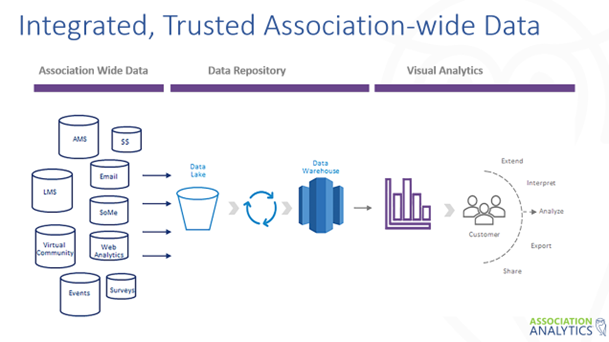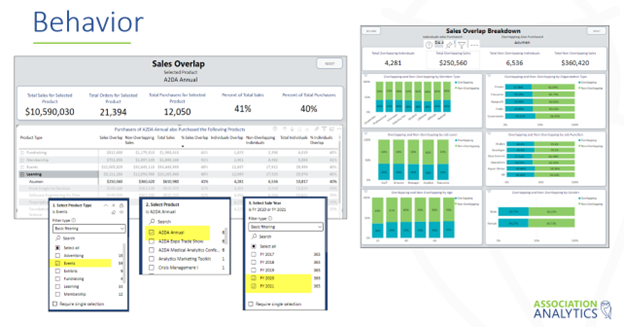Association membership marketing is much different than marketing a product for sale. Sales are instant. With membership marketing, the key is to build loyalty. Fortunately, with data, we can better understand members’ behavior and which marketing channel is most effective to reach our members. In this blog, we share tips on how to take your marketing to the next level with the help of analytics.
Approach
Let’s start by identifying the best channels and tools to maximize your campaigns. According to HubSpot, most marketers consistently leverage three channels.
- How many is your association using consistently? These could be email, SEO, social media, or paid advertising. In today’s world, success is measured by more than just clicks and open rates.
- Do you know what your most effective marketing channel is? How are you tracking success? There are many marketing technology tools that can help you measure success. These tools help you see how your campaigns are doing in real-time, so you can optimize your marketing budget by spending your money on what’s working best.
In addition to the tools, a very important piece of successful marketing is Taxonomy & Metadata – the foundation of your marketing. This is how you organize and describe your data. By carefully implementing taxonomy and metadata, you will learn more about your members and their preferences. If you don’t tag your data accurately, it will be difficult to actually see what is going on.
Are you tagging your content, products and events? By having tags in place, you can start building personas around your member’s behaviors and demographics and begin to learn what types of products and services they are interacting with and when. By defining your members’ preferences and interests, you’ll be able to target them more personally and at just the right time in their member journey.
You can learn more about content tagging and taxonomy in this blog.
Analyze Performance
Once you have your taxonomy and metadata in place, you can use metrics to analyze the performance of your marketing channels. Having this data will help you make business decisions based on trends or actual performance.
Let’s use email as an example. You might wonder if you are sending too many emails. Besides tracking the number of emails you send across the organization and the frequency, you can also view data like your opt-outs over time, the actual number of sends, and bounces to see if they are fluctuating and steady. These email performance indicators can tell you if you need to dial down the frequency of your emails or not. This could also help you justify implementing an email calendar across your association.
Here are examples of success metrics broken down by three common channels:
List Preparation
Before you can even send an email, you need to get your list scrubbed and ready. If you don’t have a process in place to get your info, we suggest that you implement a workflow for your email list requests. With or without a process in place, getting the list you want can be challenging and time-consuming. Getting your list could be delayed by relying on your colleagues to provide you with the information you need. Understanding this process is key. It is difficult to select parameters if you can’t see how these parameters work.
For example, you might request an email list and get 50,000 records or you could get 5 records. If you’re doing an A/B test or targeting your email to a certain segment, it will also be difficult to refine your list without real-time access to your data. Having better access to the data can help you refine your parameters to create a significant list for your email campaign.
Another challenge to getting the list you need is that you might not be using your data. Other people’s data is a big challenge for marketers as they own the lists and can have challenges accessing them. This information could have been compiled from another department. They may not have the same goals as you and may not have captured the data points you need for your market segmentation.
Association Analytics Tip: Always be deliberate in the data you ask for! We’ve said this before and will probably say it again.
Easy Access to All Data
With all of these tools and lists residing throughout your organization, a centralized data repository is a solution that will give your staff easy access to all of the data within your association. Using a tool that integrates all this data into one place is a worthy investment that helps you maximize the use of your data, saves your staff time and gives them more immediate and actionable insights.
Segmentation & Personas
Integrated data will help you better segment and build personas that are unique to your association. Data analytics can help you dig deeper into segmentation by starting with demographics and learning more about their behavior. You can define preferences and interests. Use demographics and behavior to help customize your marketing messages. When you have access to this data in one system and it is your source of truth, you can be more efficient with your marketing messaging. This information will help you predict what might happen next based on characteristics, previous behavior and overlap of other people’s behavior.
For example, if you see someone attended a seminar, you can suggest an online course because you observed that other people who attended that seminar purchased this course.
Here are visual examples of demographic and behavioral data using our analytics platform, Acumen.

Online Tracking
Google Analytics and Tracking Modules are two basic elements you need to track online behavior. These two tools will help you measure the success of your campaigns. They are both really easy to set up and utilize.
Google Analytics – setting this up will help you track and measure online behavior to determine the success of your marketing campaigns.
There are four categories of Google Analytics to pay attention to:
- Destination Goals – tracks when a visitor gets to a specific page. Could be a “Thanks for registering page” after someone signs up for something. This is important for conversion metrics or click-through success metrics.
- Duration – looks at how long people stay on certain pages in your site. This is really important for content-heavy sites if your success metric is time spent on your websites.
- Pages/screens per session – if your goal is to have people read content on your site longer or have them visit many pages, this is important to see if someone hits a certain threshold that could be considered a conversion.
- Event – this is really any action taken like watching a video or downloading a white paper.
UTM = Urchin Tracking Module Parameters Simply put, this is what makes your urls trackable. UTMs will help you determine the effectiveness of your campaigns by answering these questions:
- Which email/social campaigns are converting?
- Which are being ignored?
- What content and formats are most effective?
Here’s an example of how you set up UTMs to track your marketing pages:
Association Analytics Tip: if you haven’t set these up, you should do so quickly!
Attribution
This is where you start looking beyond the initial metrics of opens and clicks – and where data analytics play a major role. Keep in mind, attribution is not an exact science. This will give you a directional perspective of what is working and what isn’t. Resulting in a data-informed way to make business decisions.
For example, even though you know someone clicked on an email that led to a conversion, you don’t know if they saw another touchpoint before (social, website, etc.) So you need a directional sense of what is working and what isn’t.
You could use these touchpoints to help determine what made someone take an action.
- Last Touch – the last point that got you to convert
- First Touch – the top of the funnel tactic that brought a person in
- Linear – weight all touchpoints during a campaign equally
- Position Based – in this example, you give certain touchpoints more weight
You can us directional attributions for:
- Trend comparison – compare this year’s campaign vs. previous years’ to determine which is most effective.
- Side by side – look at campaigns year over year and identify when people took an action (for example, see if most people renew in the second quarter of the year)
- Conversion – this is pretty straight forward using the number registrations or renewal
- Proxy metrics – you may not know the exact numbers but you can see a massive spike in conversion so you can assume what is driving the traffic
- Testing – You can always run an A/B test to see what is working best
Once you have leveled up your marketing through data, you will better understand your members and be able to deliver what they need and want. This will lead to building Engagement Scores and, as all association marketers want to see, moving people up the commitment curve.
Our data-loving experts at Association Analytics would love to help you level up your marketing with analytics. In fact, one of our most popular modules in our data analytics platform, Acumen, is the marketing module! Learn more about our platform and see a 3-min demo or learn more about how we help marketers specifically.






